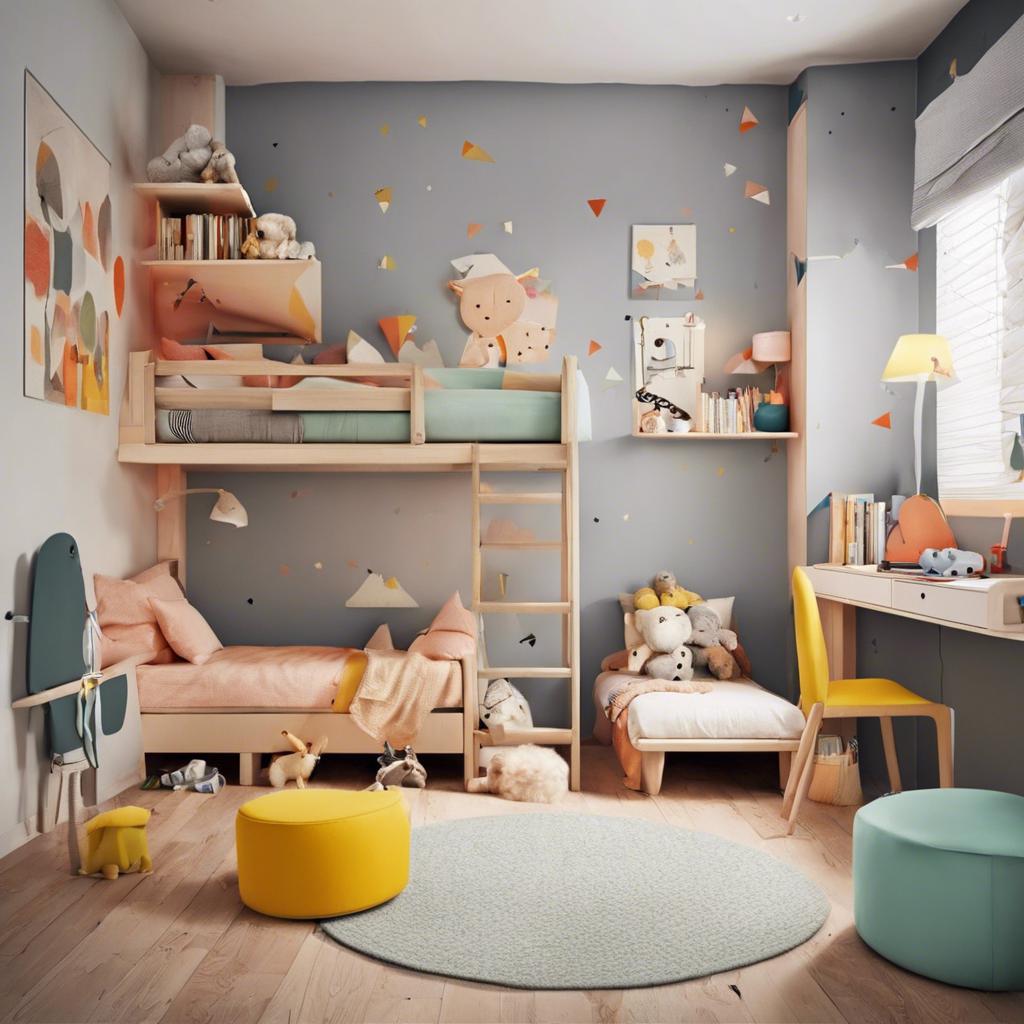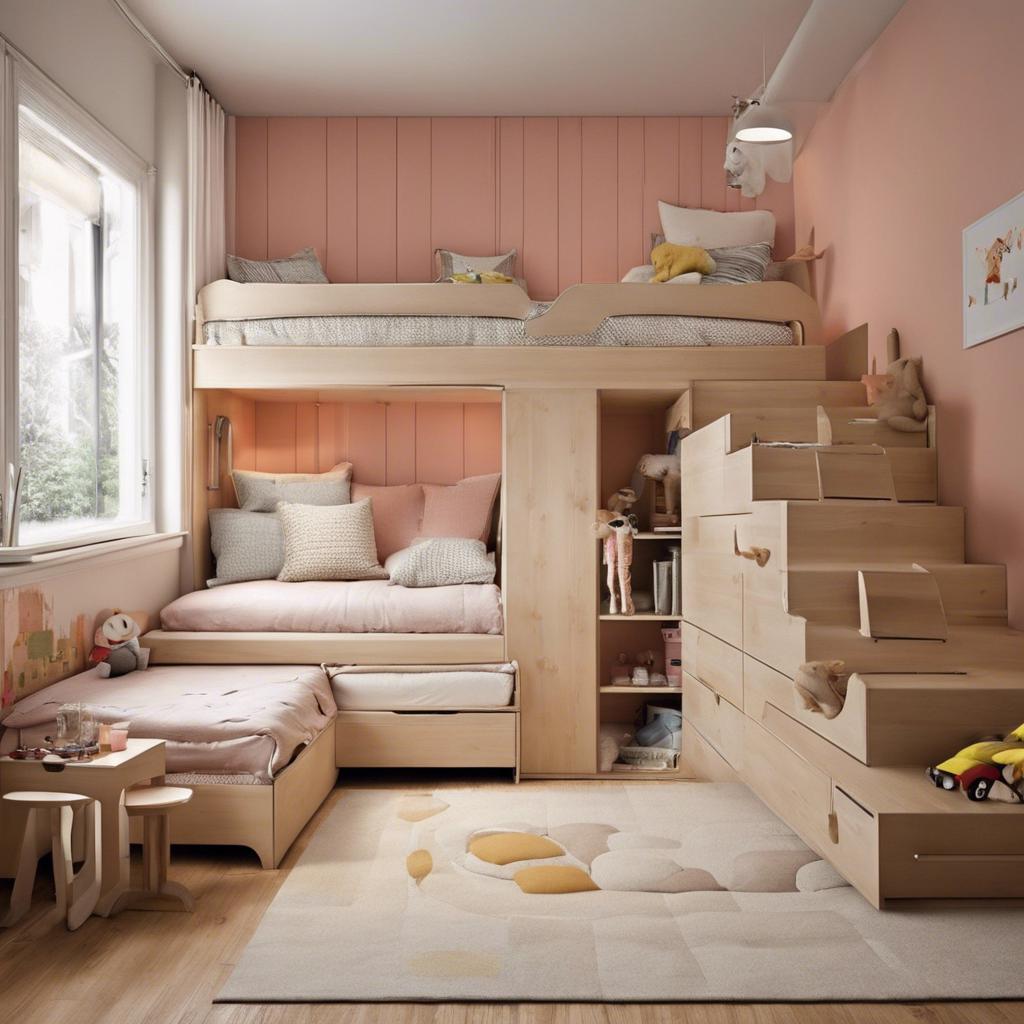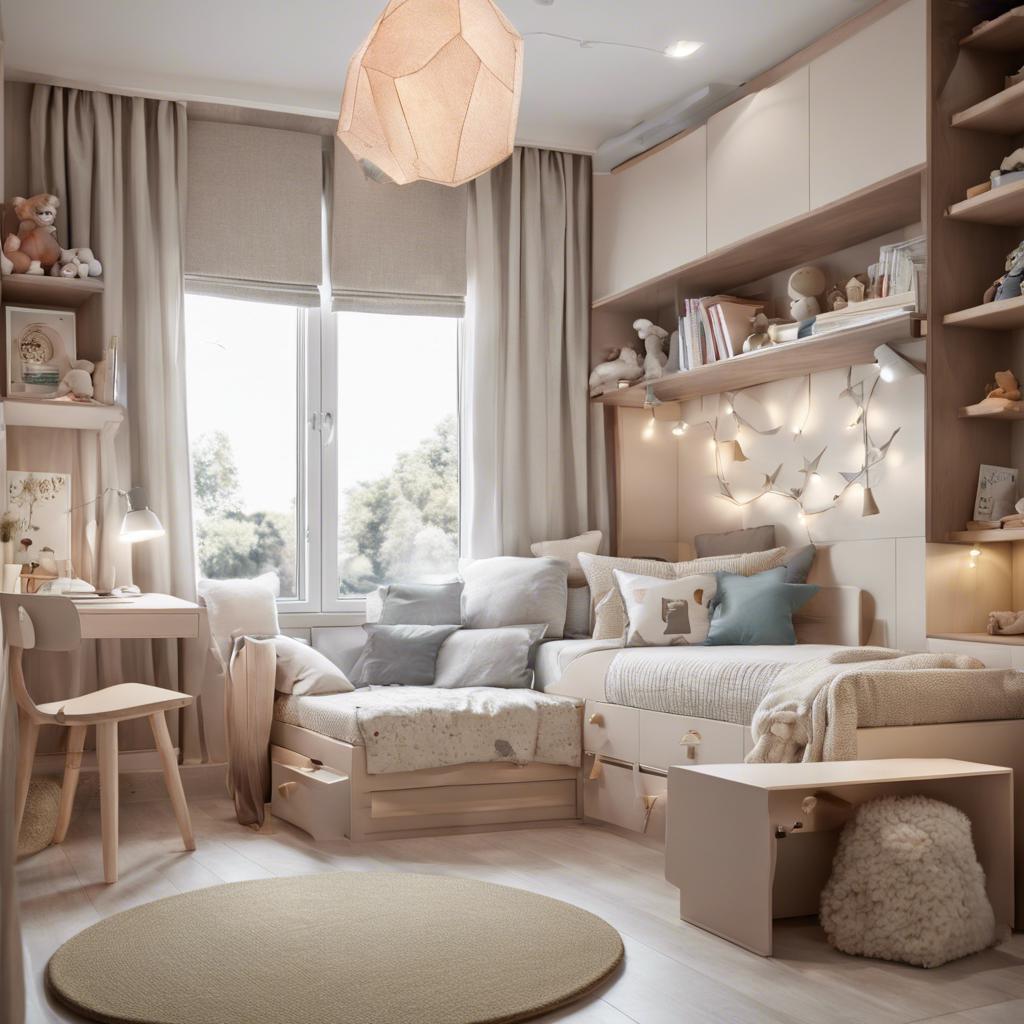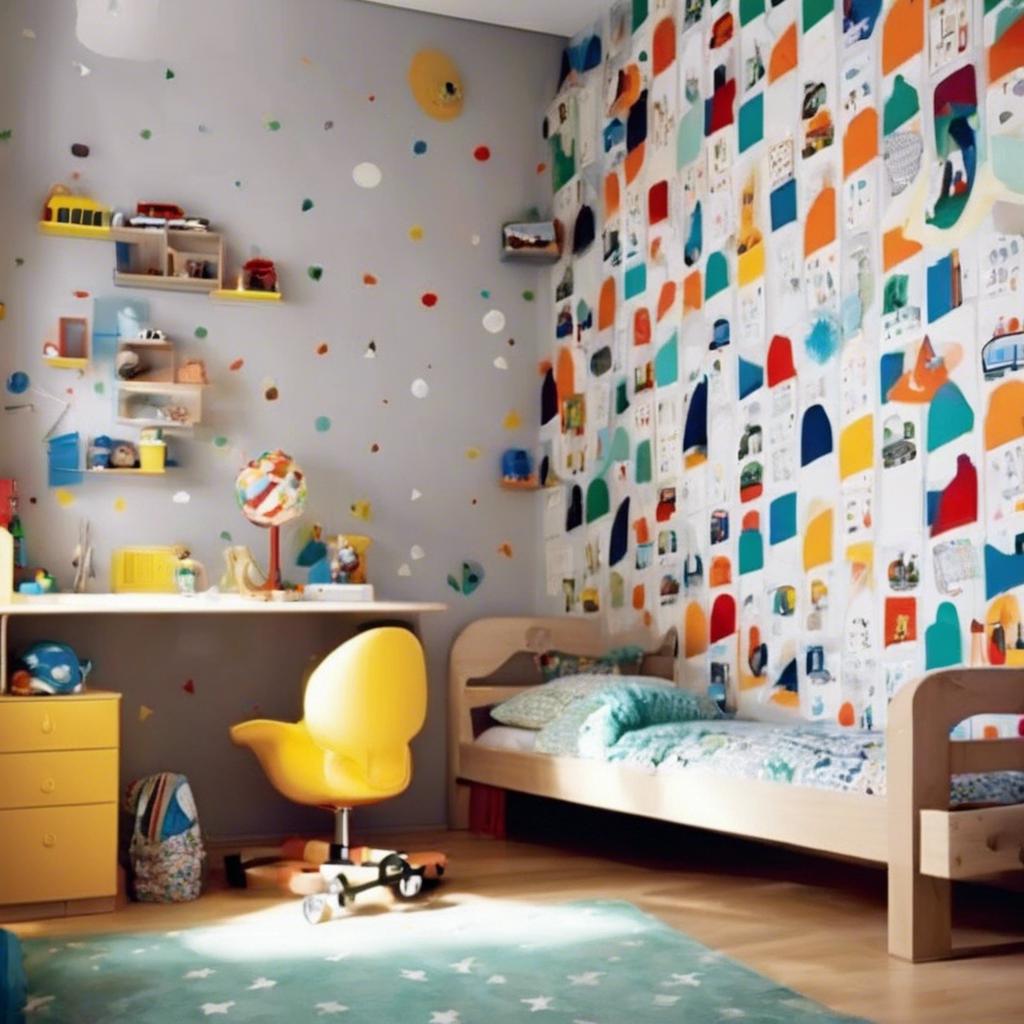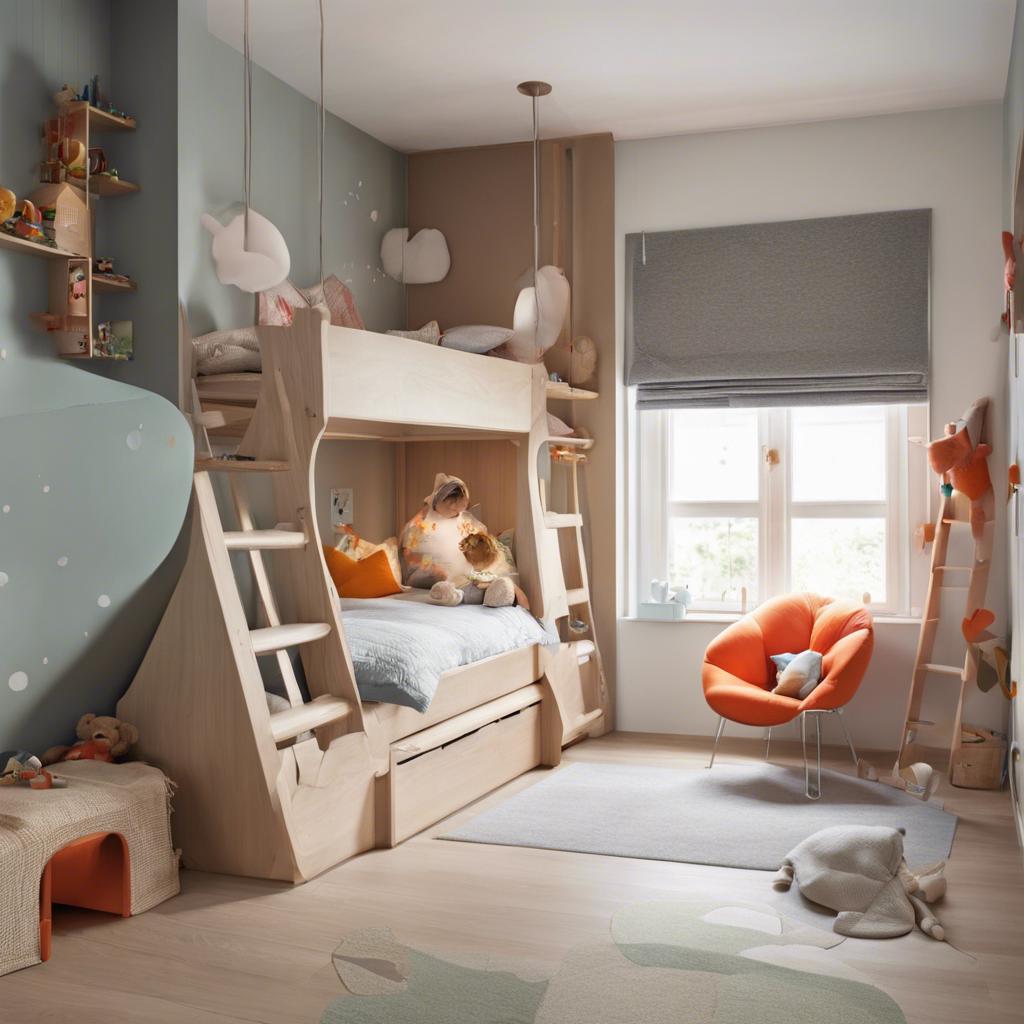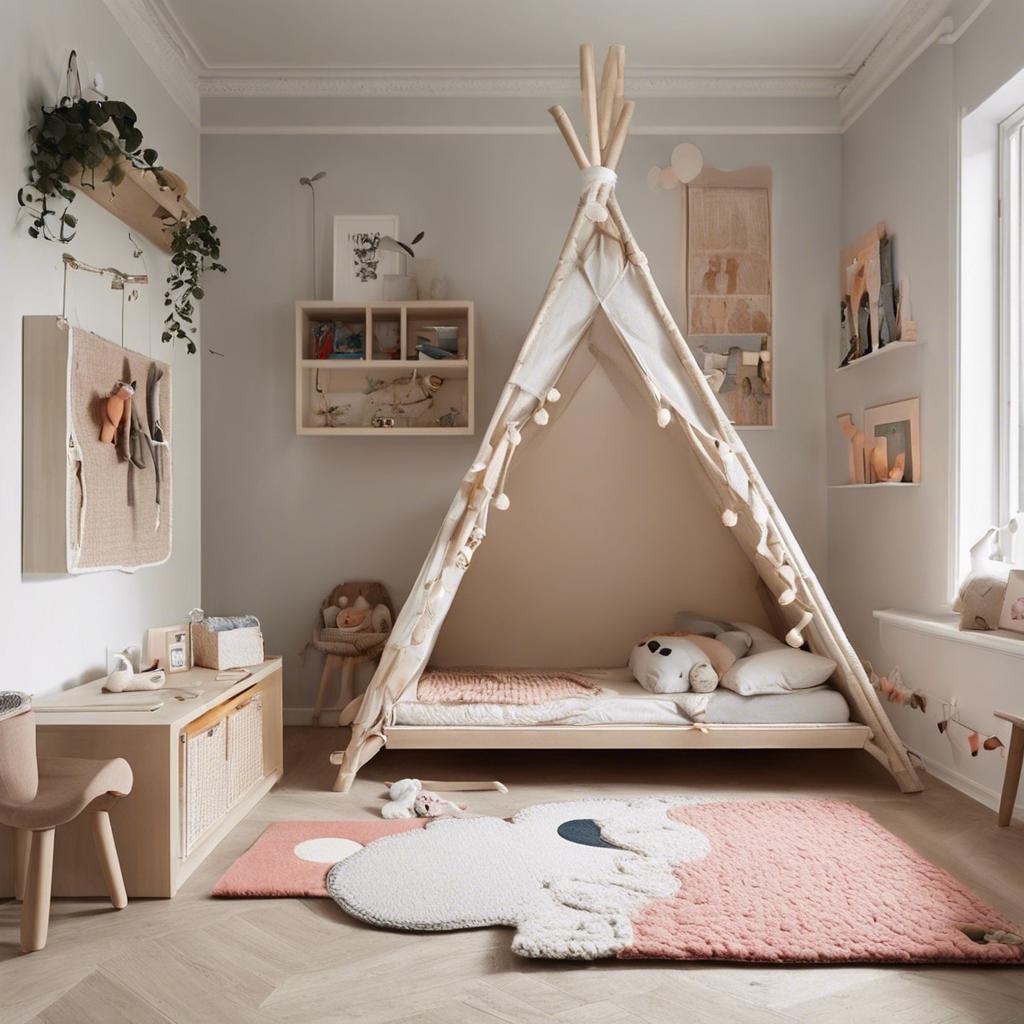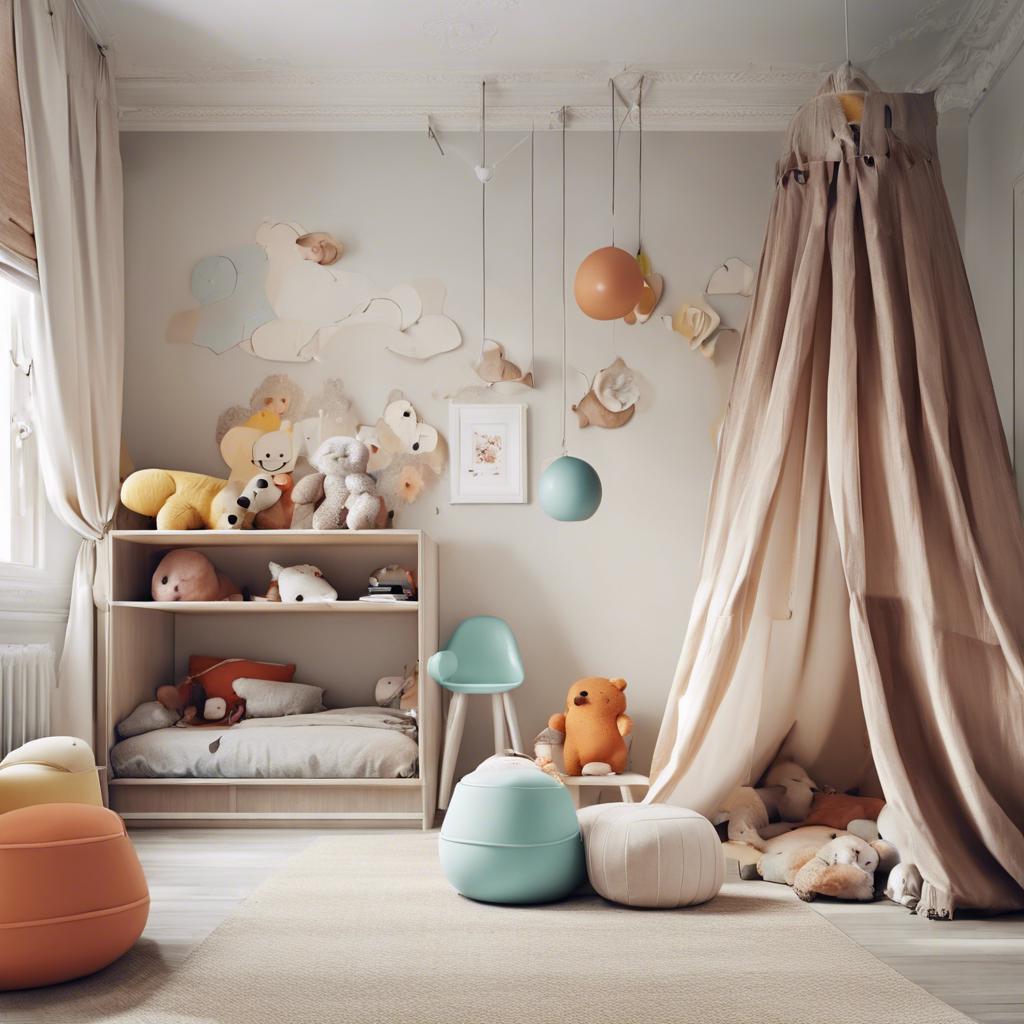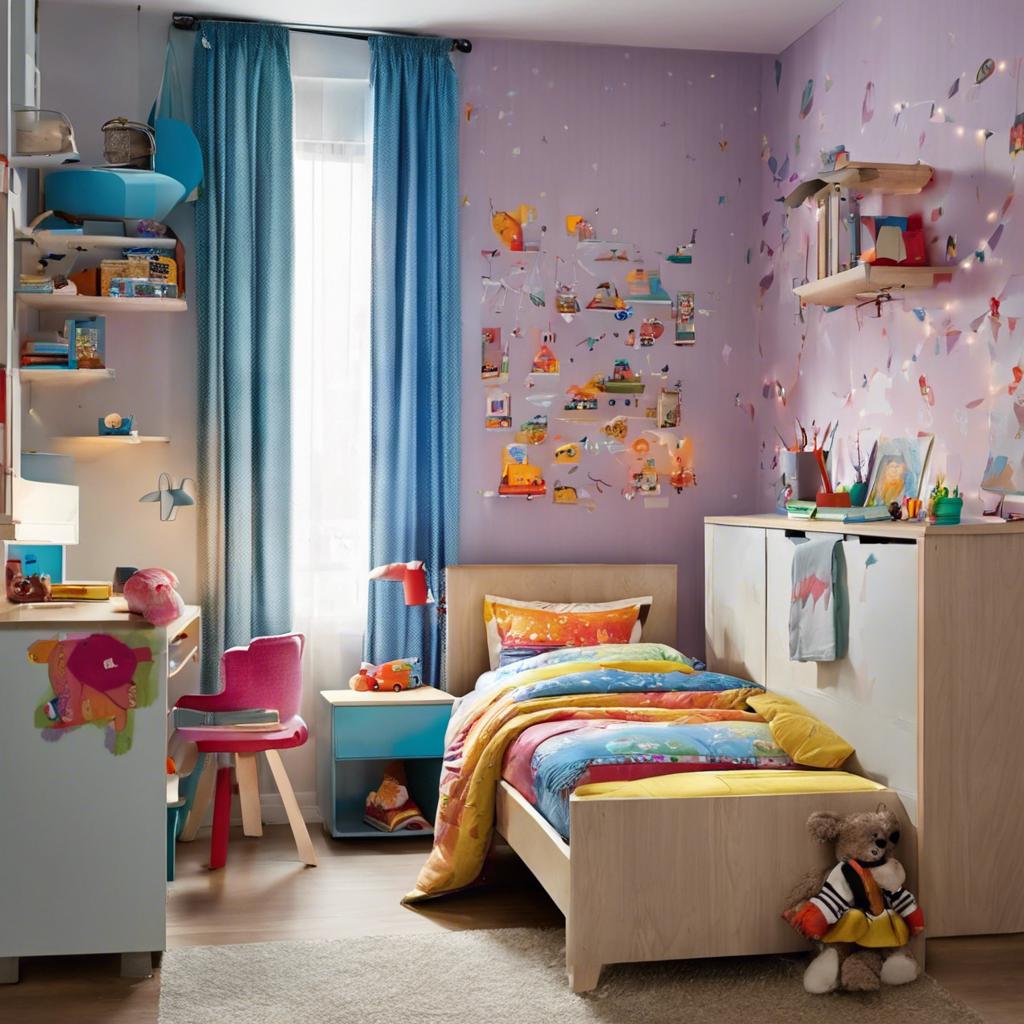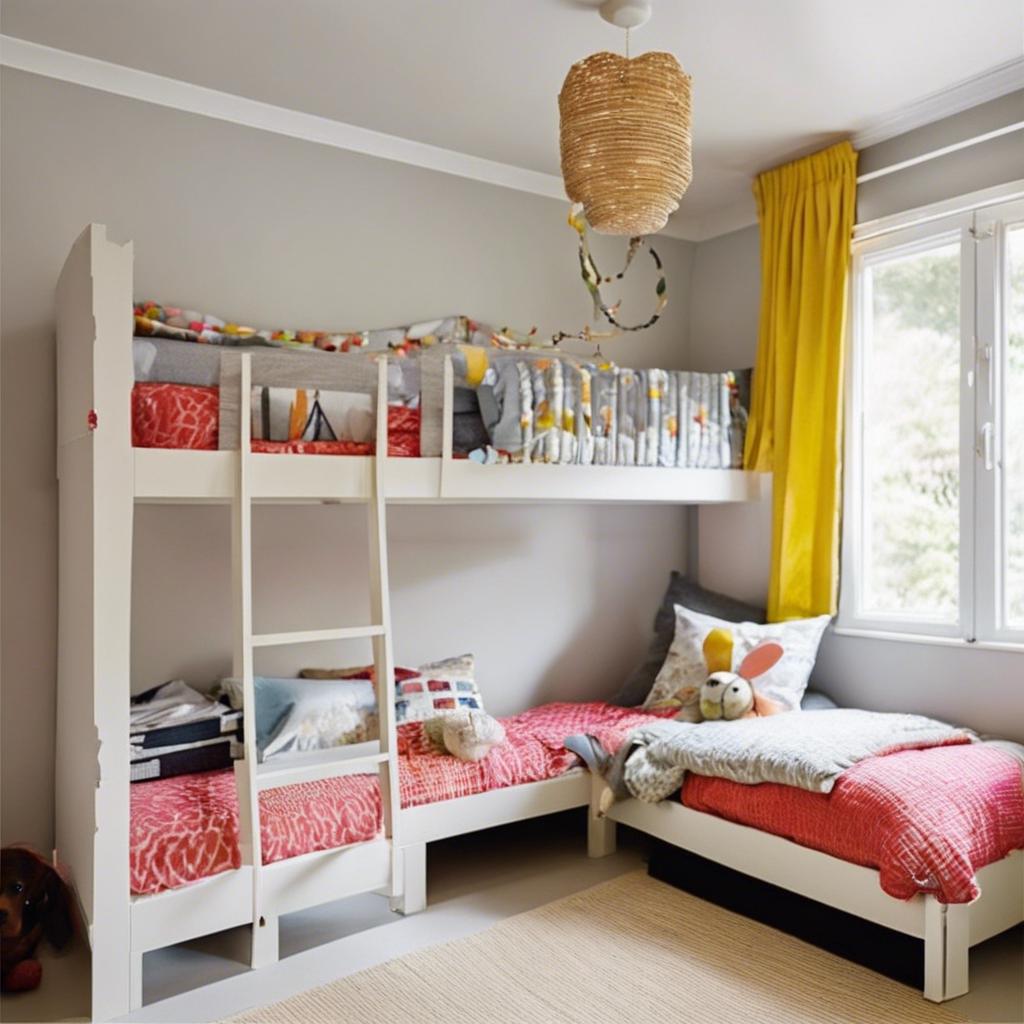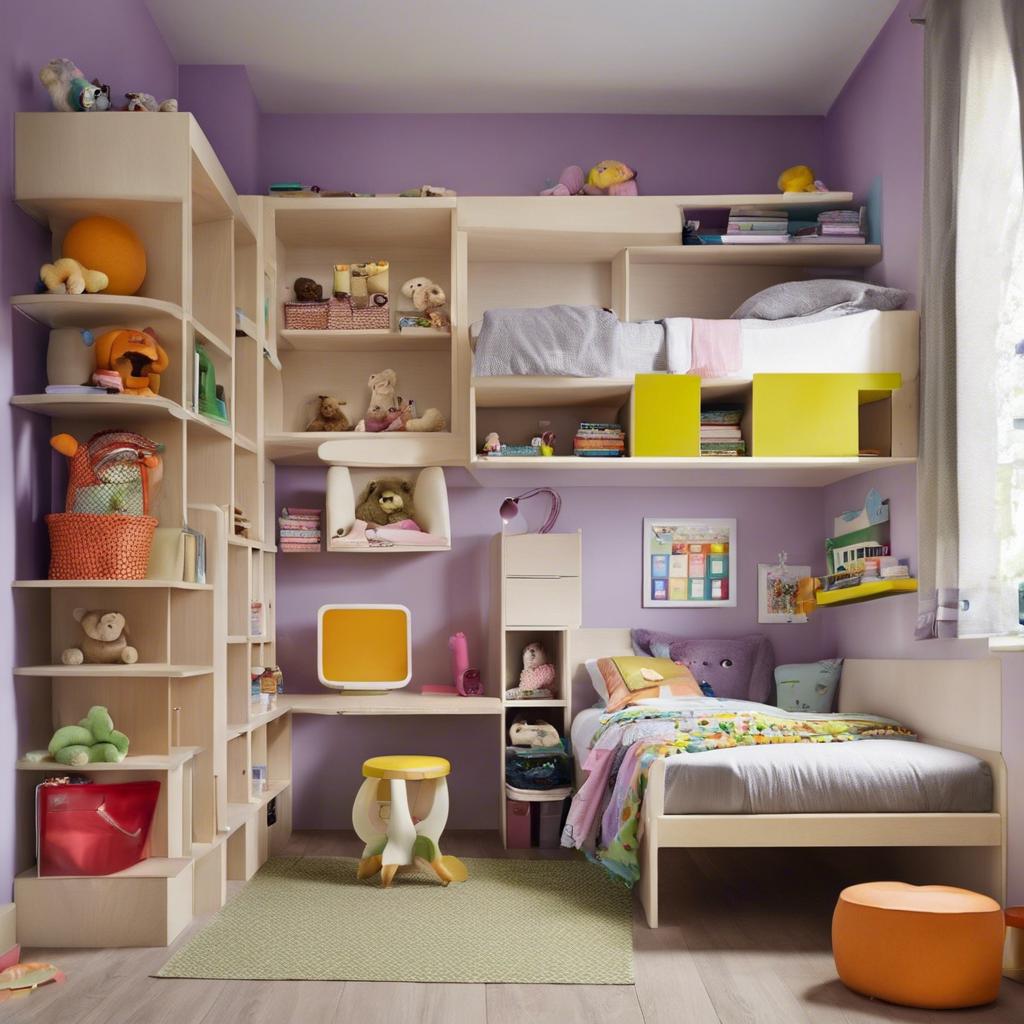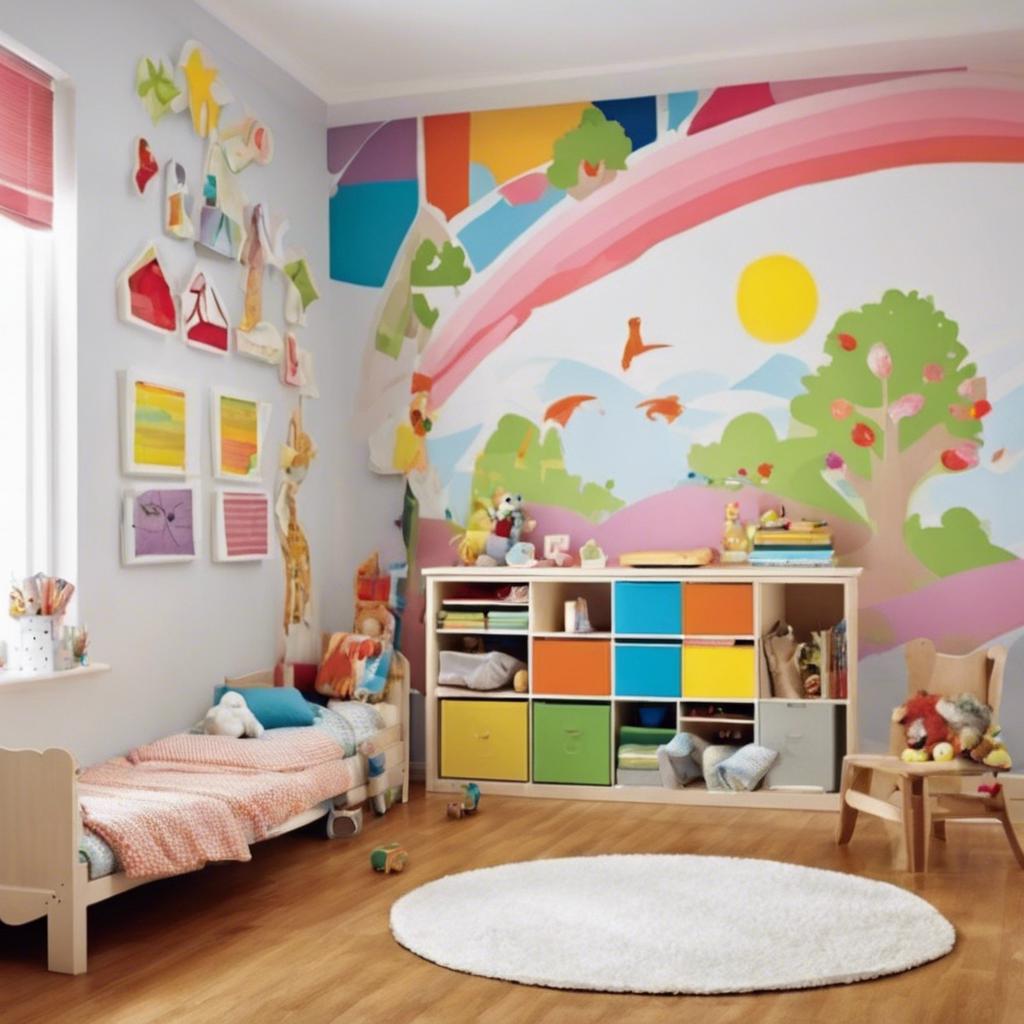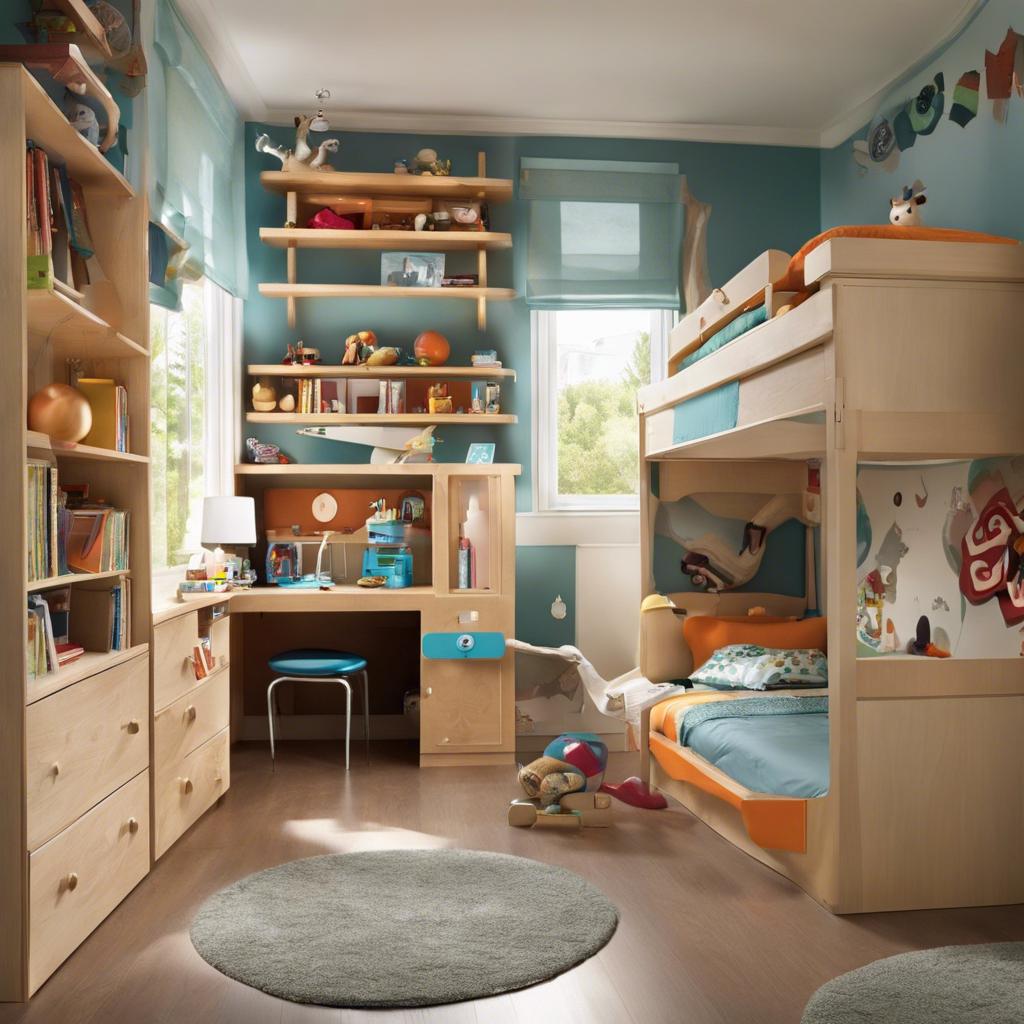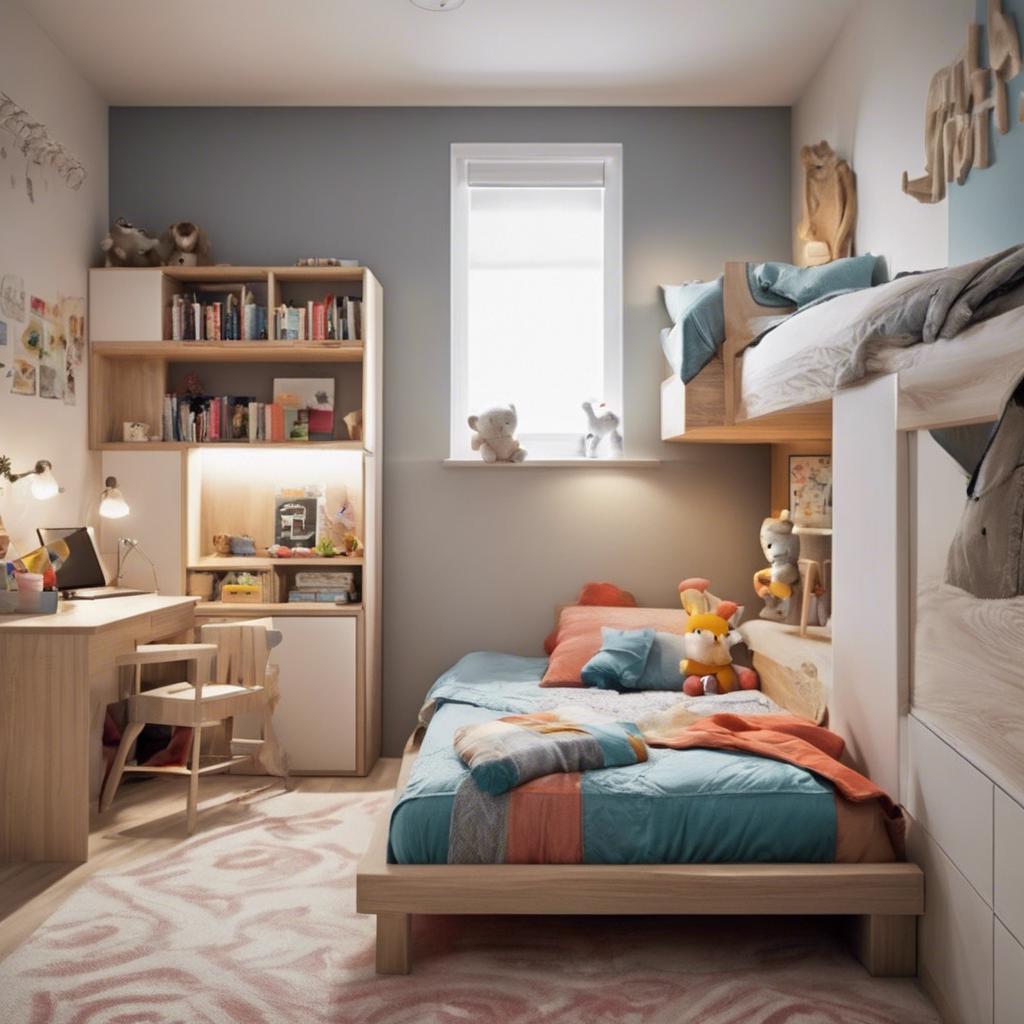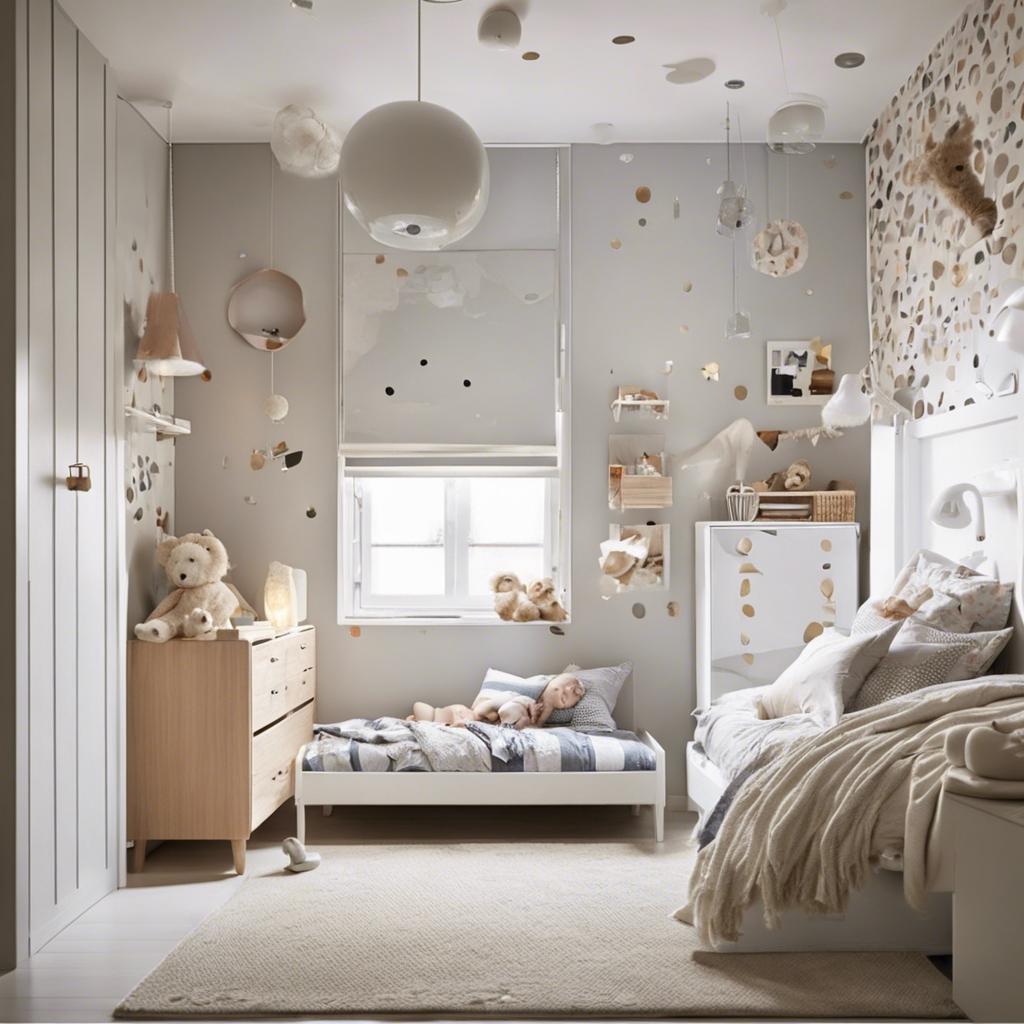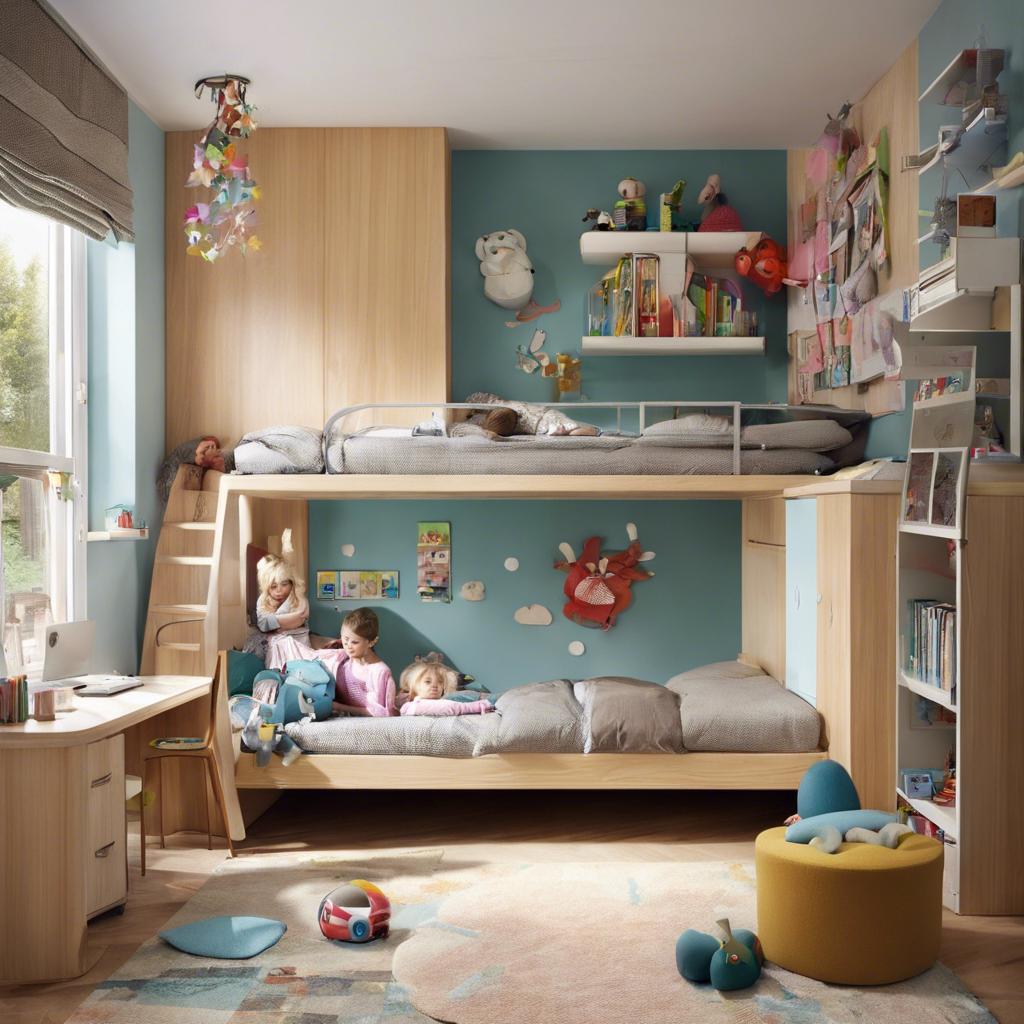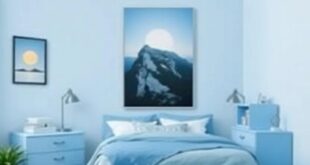In a world where space often comes at a premium, the need to optimize every nook and cranny has never been more essential—especially when it comes to designing kids’ rooms. These intimate spaces serve not just as bedrooms, but as vibrant realms of creativity, play, and growth. “Transforming Tiny Spaces: Inspiring Designs for Kids’ Rooms” explores innovative ideas that unlock the full potential of small areas, turning them into functional yet enchanting environments. From clever storage solutions to imaginative decor choices, this article showcases diverse designs that cater to both practicality and whimsy, ensuring that even the tiniest of rooms can be transformed into magical havens where children can dream, play, and learn. Join us as we delve into a world of inspiration that embraces the beauty of compact living without compromising comfort or style.
Creative Color Palettes for Small Kids Rooms
When it comes to designing a small kid’s room, color can transform the space into an imaginative wonderland. Consider using a palette that invites playfulness and creativity. A cheerful combination of soft pastels like mint green, blush pink, and buttery yellow can create a soothing yet engaging environment. Pair these lighter hues with bold accents of navy blue or bright coral through toys, bedding, or wall decals, providing a delightful contrast that energizes the room. Additionally, incorporating a neutral backdrop like light gray or creamy white allows these colors to pop without overwhelming the senses.
To highlight various zones within the room, utilize different color combinations for each area—such as sleep, play, and study. Here’s a simple inspiration table for creating thematic zones:
| Zone | Primary Color | Accent Color |
|---|---|---|
| Sleeping Area | Soft Lavender | Sunny Yellow |
| Play Area | Bright Aqua | Coral |
| Study Corner | Muted Peach | Teal |
Incorporating these color schemes not only enhances the visual appeal but also stimulates the child’s imagination, making small spaces feel larger and more inviting.
Maximizing Vertical Space in Small Kids Rooms
In the world of small kids’ rooms, vertical space is a treasure. To capitalize on this often-overlooked area, consider installing tall bookshelves or floating shelves that draw the eye upward while providing ample storage for books, toys, and art supplies. Use colorful bins or baskets on these shelves to keep the room tidy and fun, making the most of every inch. Wall-mounted pegboards can also be an excellent addition; they not only showcase your child’s creativity but serve as a functional space for hanging crafts, hats, or school materials. By shifting the focus to vertical elements, you create an illusion of height and openness that can transform the entire room.
Another innovative approach to utilize vertical space is through lofted beds. These beds elevate sleeping areas while freeing up floor space for a play zone or mini gym underneath. To add a splash of whimsy, consider a tent or canopy for a cozy hideaway. Incorporating wall decals or art above furniture can also enhance the vertical appeal without taking up any space. Here are a few more ideas to maximize that vertical potential:
- Utilize Corner Space: Corner shelves or reading nooks can effectively turn underused areas into functional spots.
- Hang Art at Varying Heights: Adorning walls with art or photos at different heights creates visual interest.
- Vertical Storage Units: Opt for dressers or storage cabinets that stretch from floor to ceiling.
Functional Furniture Ideas for Small Kids Rooms
When it comes to designing small kids’ rooms, functional furniture is the key to creating a space that is both charming and efficient. Look for pieces that have dual purposes to maximize every square inch of the room. For instance, a bunk bed can free up floor space while providing a cozy sleeping area. Consider an ottoman with hidden storage to keep toys out of sight but easily accessible when playtime rolls around. You can also opt for a folding desk that can be stowed away when not in use, allowing the room to easily transition from a study area to a play zone.
Another innovative approach is to incorporate multi-functional shelving units. These can serve as room dividers while displaying books, toys, and personal treasures. Look for options that include built-in seating or benches, making them perfect for reading nooks or collaborative projects. Don’t forget about stackable furniture units that can be rearranged as your child grows. Consider the following options that epitomize versatility:
- Convertible Crib: Transforms from a crib to a toddler bed.
- Wall-mounted Desks: Saves floor space and adds a creative workspace.
- Storage Beds: Provide under-bed storage for clothes or toys.
Incorporating Nature in Small Kids Rooms
Creating a harmonious and inviting space for little ones can be accomplished by incorporating elements of nature in their rooms. Start with a green palette—soft greens and earthy tones foster a calming atmosphere. Consider plant-themed decor, such as wallpapers featuring leaves or nature-inspired murals, to give walls a lively character without overwhelming them. Adding natural materials like wood, bamboo, or rattan in furniture will not only provide texture but also connect the room to the outdoors.
To enhance the whimsical feel of a child’s space, introduce a variety of plants that are safe for kids. Consider setting up a mini indoor garden by using hanging planters or small pots placed on shelves. You could also create a nature corner with elements like rocks, shells, or pine cones, which can serve both as decor and educational tools. Moreover, provide cozy reading nooks with cushions in shades of nature or tree branch bookshelves to inspire storytelling of adventures in the wild. This fusion of indoor play with outdoor inspiration encourages imaginative exploration while nurturing a connection to nature.
Clever Storage Solutions for Small Kids Rooms
When it comes to optimizing small kids’ rooms, think vertically! Wall-mounted shelves are an excellent way to create storage without taking up precious floor space. Consider using colorful bins for toys and books that can be easily reached by little hands. This not only keeps items organized but also makes cleanup a fun activity. Pegboards are versatile, allowing you to hang art supplies, hats, or even small bags, making the room feel personalized and creative. Additionally, incorporating a fold-down desk can provide a study space that can be tucked away when not in use, further maximizing usability.
Multi-functional furniture is another smart solution for small rooms. Bunk beds with built-in drawers offer sleeping space and ample storage for clothes and toys beneath. A trundle bed can serve as an extra sleeping option for sleepovers while also providing under-bed storage for seasonal items or extra linens. Consider using ottomans with hidden compartments or bench seating that doubles as a storage unit. This approach ensures that every piece of furniture serves a purpose, helping to maintain a tidy and inviting space for your little ones to play and grow.
The Importance of Lighting in Small Kids Rooms
Lighting plays a pivotal role in crafting an inviting and functional environment for young children. In small spaces, the right lighting can open up the room, making it feel larger and more cheerful. Natural light is particularly beneficial; it not only brightens the room but also positively influences kids’ moods and energy levels. To maximize this, consider using sheer curtains that allow sunlight to flow freely while offering a sense of privacy. For nighttime, incorporating a mix of ambient, task, and accent lighting can create a cozy atmosphere that helps children feel safe and relaxed.
When designing a child’s room, pay special attention to the type of fixtures you choose. Wall sconces can save valuable floor space, while pendant lights or chandeliers add a touch of whimsy and character. Don’t forget the power of adjustable dimmer switches; these can provide just the right amount of light for reading bedtime stories or playful activities throughout the day. Additionally, consider including fun elements like thematic nightlights to spark imagination while serving a functional purpose. Here’s a simple table to illustrate some ideal lighting choices:
| Lighting Type | Benefits |
|---|---|
| Natural Light | Enhances mood and well-being |
| Wall Sconces | Maximizes floor space and adds style |
| Pendant Lights | Creates visual interest and adds character |
| Dimmers | Custom light levels for different activities |
| Thematic Nightlights | Encourages imagination and comfort at night |
Building a Cozy Reading Nook in Small Kids Rooms
Creating a cozy reading nook in a small kids’ room can be a delightful project, transforming a bland corner into a vibrant oasis for imagination and learning. Start by selecting a comfortable seating option like a bean bag, floor cushions, or a small armchair—something that fits well into the space and is easy for little ones to get in and out of. Add a splash of personality with colorful textiles; consider using bright throws and pillows that reflect the child’s favorite characters or themes. You can also install compact shelves or use wall-mounted book holders to keep favorite stories within easy reach, ensuring the nook is both functional and fun.
Lighting is key for creating an inviting atmosphere; consider a soft, adjustable lamp or string lights to add warmth. To make it special, hang up a canopy or drapes to provide some privacy, adding a magical touch that feels like a hideaway. Decorate the space with artwork or framed pictures to inspire creativity and encourage reading. maintain an organized nook by incorporating bins or baskets for storing books, keeping the area tidy while still accessible to the young reader. With these thoughtful touches, even the tiniest of spaces can become an enchanting reading retreat.
Personalizing Walls in Small Kids Rooms
When it comes to decorating small kids’ rooms, the walls can become a canvas for imagination and creativity. A striking way to personalize the walls is by using removable wall decals that reflect your child’s interests. These decals come in various shapes and themes, such as animals, space, or fantasy, and can be easily changed as your child grows. Incorporating a colorful mural or a themed wallpaper on one accent wall can also create a focal point that adds depth and character without overwhelming the small space. Consider integrating wall-mounted shelves that can display both toys and books, allowing you to combine decor with functionality.
Another innovative approach is to create an interactive wall space. Chalkboard paint can turn a small section of the wall into a space for doodling and creativity, where your little ones can express themselves freely. Adding a gallery wall featuring framed art, their crafts, or photos of family adventures can personalize the space even further. For a touch of whimsy, consider using string lights or LED fairy lights around the edges of the wall, giving the room a cozy, magical atmosphere. Here’s a quick table to help visualize some decoration ideas:
| Decoration Type | Benefits |
|---|---|
| Removable Wall Decals | Easy to change as interests evolve |
| Chalkboard Paint | Interactive surface for creativity |
| Gallery Wall | Personalized touch with family memories |
| Wall-mounted Shelves | Combines decor with storage solutions |
Creating Zones in Small Kids Rooms
Maximizing space in small kids’ rooms can be achieved by thoughtfully creating distinct zones that cater to different activities. Consider incorporating dedicated areas for sleeping, playing, studying, and storing belongings. You might use colorful rugs to visually separate these zones while also softening the floor for playtime. Furnishing choices like lofted beds can free up floor space beneath them, allowing room for a reading nook or a small play area. By using open shelving, you can create storage zones that double as decorative elements, bringing organization and creativity together.
In addition, the use of color coding and thematic décor can clearly define each zone within the space. For instance, painting a feature wall in a calming shade near the sleeping area can help evoke restfulness, while vibrant colors in the play zone can stimulate energy and creativity. Integrating versatile furniture, such as a foldable desk or a storage ottoman, can adapt to changing needs over time. Furthermore, utilizing vertical space with wall-mounted organizers or pegboards can keep the floor clutter-free while allowing easy access to toys and art supplies.
Multi-Functional Areas for Small Kids Rooms
Creating a playful yet organized environment in small kids’ rooms requires innovative thinking and functionality. One vibrant approach is to utilize vertical space, transforming walls into imaginative storage units. Consider installing shelves adorned with colorful bins for toys and books, or hanging climbing nets for a fun climbing experience. Emergent ideas like a wall-mounted magnetic chalkboard can serve dual purposes — a canvas for creativity and a note area for reminders. The key is to blend practicality with whimsical designs, allowing for easy access while encouraging imaginative play.
Furthermore, multifunctional furniture allows parents to maximize room potential. Options like lofted beds with desks underneath or fold-out sofas can make the most of minimal square footage. Integrating benches with storage beneath can create cozy nooks while providing a place for toys to be tucked away. Consider a tablescape with movable parts to help kids get involved with their space, fostering independence. Here’s a simple comparison of ideal furniture pieces to consider:
| Furniture Type | Functionality |
|---|---|
| Lofted Bed | Maximizes vertical space, creates play or work area underneath |
| Storage Bench | Seating with hidden compartments for toys |
| Modular Tables | Flexible arrangements for crafts and games |
The Role of Rugs in Small Kids Rooms
Rugs are more than just decorative elements in a child’s small room; they serve functional and imaginative purposes. One of the primary benefits of a well-placed rug is that it creates a defined space for play, transforming a simple room into a mini-world of adventure. Soft textures offer a comfortable area for kids to sit and engage in creative activities. This is especially important for toddlers and preschoolers who spend a lot of time on the floor. Moreover, incorporating colorful patterns can stimulate their imagination, providing a backdrop for their stories and games.
In addition to enhancing playfulness, rugs also contribute to the overall safety and warmth of a child’s room. The soft surface helps to cushion falls, reducing the risk of injury during playtime. When selecting a rug, consider non-slip options, as they provide stability and prevent accidents. Furthermore, size and placement are crucial—optimally, rugs should extend beyond furniture to create an inviting ambiance. Here’s a simple table highlighting key factors to consider when choosing rugs for children’s spaces:
| Factor | Suggestion |
|---|---|
| Material | Choose hypoallergenic and durable materials |
| Size | Opt for larger rugs to unify the space |
| Design | Pick vibrant colors and playful patterns |
| Maintenance | Look for easy-to-clean options like machine-washable rugs |
Designing Playful Areas in Small Kids Rooms
When space is limited, creativity becomes your best ally in crafting playful areas for young children. Incorporating multi-functional furniture can maximize room usage while inviting opportunities for imaginative play. Consider bunk beds with slides, which not only save floor space but also integrate a fun element that encourages active engagement. Colorful shelving units can display toys and books, serving as both decor and an accessible play area. By using removable wall decals, you can also transform plain walls into interactive storybooks, allowing kids to explore their creativity through art while ensuring easy updates as their interests evolve.
To create nooks for quiet times and inspired play, think about layering textures and colors. Bright rugs can define spaces, while floor cushions offer soft seating that invites reading or storytelling. Use vertical space wisely—wall-mounted chalkboards or magnetic boards provide surfaces for artistic expression without consuming valuable real estate on the floor. Consider the following table for a quick reference on playful design elements that can be adapted for small kids’ rooms:
| Design Element | Benefit |
|---|---|
| Convertible furniture | Maximizes functionality and space |
| Bright colors | Stimulates creativity and joy |
| Interactive wall decals | Encourages art and storytelling |
| Defined play zones | Creates focused areas for different activities |
Inspiring Themes for Small Kids Rooms
Designing a space for small kids can be both fun and challenging, but the right themes can transform a tiny room into a magical retreat. Consider a whimsical forest theme, where soft greens and browns set the backdrop. Adorn walls with tree decals and add plush animal friends scattered around the room for a cozy feeling. Incorporate a starlit sky on the ceiling with glow-in-the-dark elements to encourage a sense of wonder at bedtime. Other inspiring themes could include a playful ocean with wave-styled furniture and marine life accents or a space adventure complete with rocket ship beds and twinkling star mobiles. Each theme can create a vivid narrative that not only sparks imagination but also aids in creating a comforting environment.
Color and décor play pivotal roles when it comes to small spaces. Soft pastels can create an airy feel, while bold accent colors provide opportunities for playful touches. Wall-mounted shelves can showcase books and toys, keeping the floor space free for play. Consider integrating multi-functional furniture such as a bed with built-in storage or a desk that folds away when not in use. For inspiration, here’s a quick comparison of popular themes:
| Theme | Main Colors | Key Features |
|---|---|---|
| Whimsical Forest | Green, Brown, Soft Neutrals | Tree Decals, Animal Plushies |
| Playful Ocean | Blue, Aqua, Coral | Wave Furniture, Marine Accents |
| Space Adventure | Black, Silver, Bright Colors | Rocket Ship Beds, Star Mobiles |
Choosing Durable Fabrics for Small Kids Rooms
When it comes to designing rooms for small children, the choice of fabric is crucial for both aesthetics and functionality. Look for materials that can withstand the wear and tear of youthful energy while still providing a cozy and inviting atmosphere. Durable fabrics not only resist stains and fading but also contribute to the longevity of your investment. Consider these fabric options:
- Cotton canvas: Sturdy and easy to clean, making it perfect for everything from curtains to upholstery.
- Microfiber: Soft, durable, and resistant to stains, suitable for cushions and bedding.
- Denim: A robust fabric that adds a touch of style, ideal for chair covers and accent pieces.
Additionally, it’s important to consider ease of maintenance when selecting fabrics. Look for options that are machine washable or can be wiped clean, ensuring that little messes won’t lead to major headaches. To help you make a decision, refer to the table below comparing a few popular fabric types based on durability and maintenance:
| Fabric Type | Durability Rating | Maintenance Ease |
|---|---|---|
| Cotton Canvas | 4/5 | Machine washable |
| Microfiber | 5/5 | Wipe clean |
| Denim | 4/5 | Machine washable |
Smart Organization Tips for Small Kids Rooms
Maximizing space in a child’s room requires a mix of creativity and practicality. Start by incorporating multi-functional furniture that serves more than one purpose, such as a bed that includes drawers or a desk that doubles as a craft area. For vertical storage solutions, consider using floating shelves or wall-mounted pegboards where little ones can display their favorite toys, books, or artwork. This not only adds personality to the space but also keeps the floor clear for play. Implementing a color-coded organization system can also help kids learn to tidy up by simply matching items to their respective colors.
Another effective strategy is to harness the power of baskets and bins. Label these containers with words or pictures for quick identification, teaching children how to sort and understand their belongings. Utilize the space under the bed with rolling storage bins, perfect for stowing away seasonal clothes or extra toys. To further enhance the room’s design, you can create zones by using rugs or colorful mats to define areas for sleeping, playing, or reading, making the small space feel inviting and organized. This approach cultivates an environment that fosters creativity while maintaining order.
Artistic Wall Décor for Small Kids Rooms
When it comes to maximizing the charm of small kids’ rooms, artistic wall décor can work wonders. Custom murals, whimsical decals, and framed art can ignite imagination while adding personality to limited spaces. Consider themed designs that resonate with your child’s interests, transforming blank walls into vibrant canvases reflecting their unique style. Soft colors and playful patterns foster a sense of warmth, making the room inviting and cheerful. Ideas to consider include:
- Nature-Inspired Murals: Bring the outdoors in with trees, animals, or constellations.
- Interactive Wall Art: Utilize chalkboard paint or magnetic boards for creative expression.
- Gallery Walls: Create a rotating collection of your kids’ art alongside family photos.
Incorporating 3D elements, such as shelf-mounted installations or hanging mobiles, can enhance the visual interest of the room. Lightweight and removable décor, like fabric wall hangings or adhesive strips, allow for flexibility as your child’s tastes evolve. To keep the balance between creativity and functionality, consider using double-duty items. For example:
| Item | Function |
|---|---|
| Wall Pockets | Store books or toys while adding color. |
| Art Ledges | Display rotating artwork without damaging walls. |
| Storybook Murals | Create a storytelling nook that sparks imagination. |
Boosting Imagination with Interactive Elements in Small Kids Rooms
Creating an imaginative space for small kids is essential for fostering creativity and exploration. Interactive elements such as chalkboard walls, magnetic paint, and paintable wallpaper can transform a simple room into a lively canvas that encourages self-expression. Imagine a wall where your child can freely draw or a corner filled with colorful blocks that can be rearranged into various configurations. Incorporating these features not only enhances playtime but also encourages problem-solving and storytelling, making the room a dynamic environment that evolves with your child.
To maximize space and keep things engaging, consider these interactive solutions:
- Hidden Storage Compartments: Utilize furniture with built-in storage to keep the room tidy and serve as a play area.
- Interactive Shelves: Install shelves where kids can rearrange their favorite books or toys, transforming the room layout periodically.
- Augmented Reality Wall Art: Fill the walls with designs that come to life through a mobile app, blending technology and art.
These elements not only enhance the aesthetic but also play a crucial role in supporting a child’s growth and imagination. By carefully curating a mix of interactive features, you can create a magical space that inspires endless adventures in even the smallest of rooms.
Incorporating Technology in Small Kids Rooms
In today’s digital age, integrating technology into small kids’ rooms can enhance both functionality and fun. Introducing tech-savvy elements transforms these tiny spaces into interactive environments that stimulate young minds. Smart storage solutions like app-controlled shelving can help keep toys organized, while LED night lights with color-changing features can create a soothing bedtime atmosphere. Additionally, integrated sound systems or Bluetooth speakers offer easy access to music and audiobooks, allowing for a cozy reading corner or a mini dance party, all in a confined space.
When selecting gadgets for a child’s room, it’s essential to balance innovation with safety. Consider durability and ease of use as top priorities, ensuring that devices withstand the rigors of playtime. Some popular options include:
- Interactive projectors: Transforming walls into enchanting displays or educational tools.
- Smart rugs: Offering engaging games or learning apps activated by foot-pads.
- Tablets with parental controls: For safe browsing and educational activities.
A well-planned layout can easily incorporate these elements without making the room feel cluttered. Here’s a simple table to guide you on choosing technology by age group:
| Age Group | Recommended Technology |
|---|---|
| 0-3 years | Interactive toys with sound and light features |
| 4-6 years | Tablets or e-readers with educational apps |
| 7-10 years | Smart gaming consoles for interactive learning and fun |
Choosing the Right Bed for Small Kids Rooms
When it comes to selecting a bed for a small kids’ room, functionality and style need to go hand in hand. Opting for a space-saving design can greatly enhance the usability of the room. Consider these features when choosing the perfect bed:
- Bunk beds – Perfect for sharing rooms; they maximize floor space and often include extra storage.
- Loft beds – Elevate the sleeping area, providing space beneath for a play area or desk.
- Storage beds - With drawers integrated into the frame, these beds keep toys and clothes easily accessible.
- Toddler beds – Transitioning from a crib, these smaller-sized beds are great for safety and comfort.
In addition to selecting the right bed type, consider the overall aesthetics of the room. Incorporating creative decor and color schemes can make even the tiniest space feel larger and more inviting. Here’s a table to inspire your design choices:
| Bed Type | Style Ideas |
|---|---|
| Bunk Bed | Use bright colors and fun bedding to make it a feature piece. |
| Loft Bed | Add fairy lights and a cozy reading nook beneath. |
| Storage Bed | Personalize with labels on drawers to foster organization. |
| Toddler Bed | Create a theme with wall stickers that match the bedding. |
Shelf Displays that Spark Joy in Small Kids Rooms
When it comes to organizing a child’s room, shelf displays can be both functional and enchanting. Imagine vibrant shelves adorned with personalized touches that invite little ones to explore. The right shelves can turn clutter into an engaging display while promoting independence in choosing toys or books. Consider incorporating colorful bins, whimsical bookends, or decorative storage boxes to keep everything tidy and appealing. Playful shapes like clouds, animals, or stars can add a dash of fantasy to the space, transforming ordinary shelving into a magical corner where imagination flourishes.
To really spark joy, use a mix of open and closed shelving, allowing kids to easily access their favorite items while keeping some treasures out of sight. An inspiring touch might include a rotating display for seasonal toys or a small, framed chalkboard where kids can showcase their latest artwork. Layering textures is crucial—mix wooden shelves with fabric pull-out drawers or wire baskets that can breathe life into the space. Here are a few ideas to consider:
- Floating shelves for books and collectibles
- Magnetic strips for displaying artwork
- Color-coded baskets for easy sorting
- Labelled jars for small toys or craft supplies
Using Mirrors to Enhance Small Kids Rooms
Incorporating mirrors into children’s rooms can create an illusion of space while also serving as a playful element in the design. Large, playful-shaped mirrors can act as a focal point, bringing a sense of whimsy that resonates with the youthful spirit of the room. Consider these playful ideas for mirror placement:
- Position a mirror opposite a window to reflect natural light, making the room feel brighter and more open.
- Use cluster arrangements of smaller mirrors to create an artistic gallery wall.
- Choose mirrors with colorful borders or fun shapes, such as stars or animals, to enhance the décor.
Safety is paramount when using mirrors in kids’ spaces, so opting for shatter-proof or acrylic mirrors is advisable. Additionally, place mirrors at heights where children can safely engage with them, encouraging imaginative play and self-reflection. To further elevate the space, consider a small table adorned with decorative mirrors that can also double as a creative play area. Explore these practical tips to maximize their functionality:
| Mirror Type | Details |
|---|---|
| Full-Length Mirror | Encourages self-concept and dressing-up play. |
| Wall Decals with Mirrored Finish | Safe and easy to apply; adds dimension without bulk. |
| Decorative Handheld Mirrors | Promote creativity and role-play activities. |
Involving Kids in the Design of Their Small Kids Rooms
Getting kids involved in the design of their small rooms not only ensures that the space reflects their unique personality but also fosters a sense of ownership and responsibility for their environment. Start by organizing a brainstorming session with your child, where you can discuss various themes, colors, and layouts that excite them. This collaborative process can be made fun with activities like drawing mood boards, choosing color swatches, or even exploring design apps that allow them to visualize their ideas. They may be interested in incorporating elements like quirky wall decals, imaginative bedding, or personalized storage solutions, all of which can help them feel empowered in their space.
To simplify the design process, consider creating a design wish list that includes key features they want in their room. You can break this down into categories such as:
- Furniture: Bed type, desk for homework, storage solutions
- Decor: Wall art, curtains, rugs
- Functionality: Play areas, study areas, reading nooks
Additionally, using a flexible layout can allow for easy modifications as their interests evolve. Here’s a simple layout plan that can help you visualize how to maximize space:
| Area | Purpose |
|---|---|
| Corner Nook | Reading space with bean bags |
| Wall Shelves | Display books and toys |
| Bed with Storage | Maximize floor space |
Budget-Friendly Tips for Small Kids Room Transformations
Transforming a small kids’ room doesn’t have to drain your wallet. Start with a decluttering session; remove toys and furniture that are no longer useful. This not only creates space but also allows you to reimagine the room’s layout. Next, consider repurposing existing furniture. A simple coat of paint can breathe new life into a worn dresser, while an old bookshelf can be transformed into a fun art station. Don’t underestimate the power of accessories; adding colorful throw pillows or playful wall decals can instantly uplift the ambiance without costing much.
For storage solutions, look for multi-functional furniture. A bed with built-in drawers or a bench that doubles as storage can keep the room organized while maximizing floor space. Utilize vertical space with wall-mounted shelves that can hold books and toys, transforming walls into engaging learning or play zones. You might also consider simple DIY projects; for example, crafting your own wall art from recycled materials not only saves money but also adds a personal touch. Below is a table highlighting some budget-friendly ideas:
| Item | Repurpose Idea | Estimated Cost |
|---|---|---|
| Dresser | Paint & Use as Toy Storage | Under $50 |
| Old Bookshelf | Turn into an Art Station | Free with DIY |
| Bench | Storage & Seating | About $30 |
| Wall Space | Install Shelves | Under $20 |
Q&A
Q&A: Transforming Tiny Spaces – Inspiring Designs for Kids’ Rooms
Q: Why is designing a kids’ room particularly challenging when space is limited?
A: Designing a kids’ room in a tiny space can be a delightful puzzle. The challenge lies in creating a harmonious environment that accommodates sleeping, playing, and studying—all essential parts of a child’s life. Limited space requires creativity to maximize functionality without sacrificing style.
Q: What are some key design principles when working with small children’s rooms?
A: Focus on multifunctionality, scalability, and personalization. Utilize furniture that serves multiple purposes, such as beds with storage drawers or convertible desks that can adapt as your child grows. Keeping colors light and bright can also create an illusion of space, while personal touches like artwork and favorite themes make the room inviting and engaging.
Q: How can vertical space be utilized effectively in small kids’ rooms?
A: Vertical space is a superhero in small rooms! Use wall-mounted shelves for books and toys or incorporate tall storage units that take advantage of upward height. Bunk beds can free up floor space, providing much-needed room for play. Don’t forget hooks and pegboards—perfect for hanging bags, costumes, or even art supplies.
Q: What are some fun and creative themes for kids’ rooms that work well in a small area?
A: Themes can transform a room—consider a whimsical forest with tree decals and soft green accents, or an oceanic adventure with blues and sea creature motifs. A space-themed room can be captivating too, using dark colors with glow-in-the-dark stars for ceiling decor. These themes can help make the most of space while firing up a child’s imagination.
Q: Are there any color schemes that are particularly effective for small rooms?
A: Yes! Light colors like pastels or whites can make a room feel larger and airier. Consider a monochromatic palette with pops of color through accessories like cushions or bed linens. Additionally, using a bold accent wall can create a stunning focal point without overwhelming the entire space.
Q: How can parents balance between child-friendly designs and styles that appeal to adults?
A: Striking a balance involves integrating playful elements with sleek design. Choose furniture that’s sturdy and playful but also sophisticated in shape and finish. Opt for a neutral base and accessorize with fun, interchangeable decor items that can easily be updated as tastes evolve.
Q: What role does organization play in maximizing small kids’ rooms?
A: Organization is paramount in small spaces! Efficient storage solutions like labeled bins, under-bed storage, and vertical organizers help keep clutter at bay. Teaching kids the importance of organization fosters good habits while ensuring that their spaces remain functional and tidy.
Q: How can parents involve their children in the design process of their room?
A: Involvement can foster creativity and ownership. Encourage children to express their preferences through mood boards or by selecting a theme they love. Let them choose decorations or bedding within a parent-approved framework. This collaboration not only ensures that the room reflects their personality but also makes them feel valued and heard.
Q: What’s the one takeaway for anyone considering redesigning a small kid’s room?
A: Embrace the challenge! A small room doesn’t mean limited potential; it’s an opportunity for innovative solutions and unique designs. With thoughtful planning and creativity, even the tiniest of spaces can become a magical haven for children to thrive.
In Conclusion
As we conclude our journey through the imaginative realm of transforming tiny spaces into vibrant kids’ rooms, it becomes clear that creativity knows no bounds, even in the coziest corners of our homes. The designs and ideas presented here not only reflect functionality but also celebrate the spirit of childhood — a time filled with wonder, exploration, and growth. Whether you find inspiration in the artful organization of play areas, the clever use of color, or the incorporation of multi-purpose furniture, remember that every inch holds potential.
By embracing the unique challenges of small spaces, we can craft environments that foster creativity and joy for our little ones. As you embark on your own design adventure, may you find the perfect blend of style and practicality that your child will cherish for years to come. Transforming tiny spaces into magical havens is not just about aesthetics; it’s about creating a canvas for imagination, one where dreams take flight, stories unfold, and memories are made. Let these ideas spark your creativity, guiding you to design a room that truly feels like home. Happy decorating!
As an Amazon Associate I earn from qualifying purchases.
 decorafit.com Design ideas for your home and patio
decorafit.com Design ideas for your home and patio

